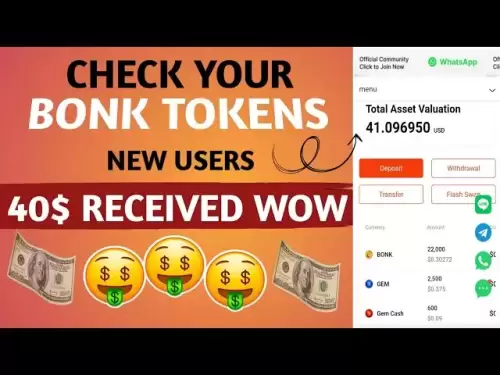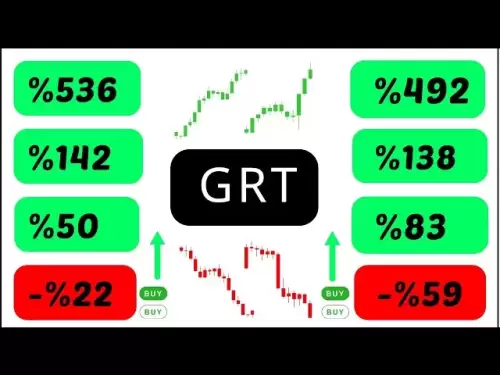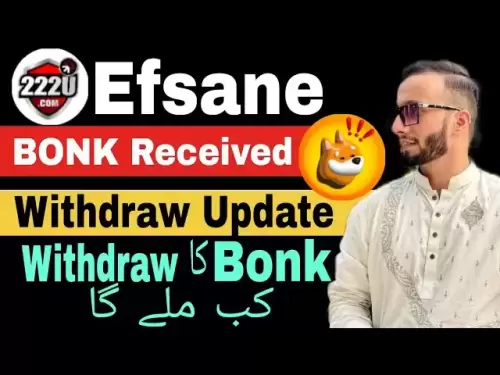-
 Bitcoin
Bitcoin $107,569.2021
1.41% -
 Ethereum
Ethereum $2,430.6950
-0.48% -
 Tether USDt
Tether USDt $1.0005
-0.01% -
 XRP
XRP $2.1884
-0.91% -
 BNB
BNB $647.4445
0.53% -
 Solana
Solana $144.2325
-0.49% -
 USDC
USDC $1.0000
-0.02% -
 TRON
TRON $0.2731
-0.48% -
 Dogecoin
Dogecoin $0.1658
0.61% -
 Cardano
Cardano $0.5694
-2.94% -
 Hyperliquid
Hyperliquid $37.2814
-0.09% -
 Bitcoin Cash
Bitcoin Cash $487.9461
7.41% -
 Sui
Sui $2.7788
-0.50% -
 Chainlink
Chainlink $13.2000
-1.28% -
 UNUS SED LEO
UNUS SED LEO $8.9994
0.22% -
 Stellar
Stellar $0.2417
-2.68% -
 Avalanche
Avalanche $17.6551
-2.73% -
 Toncoin
Toncoin $2.8498
-1.64% -
 Shiba Inu
Shiba Inu $0.0...01166
0.35% -
 Litecoin
Litecoin $84.6510
-0.54% -
 Hedera
Hedera $0.1507
-2.44% -
 Monero
Monero $315.5116
-0.39% -
 Ethena USDe
Ethena USDe $1.0001
-0.04% -
 Polkadot
Polkadot $3.3900
-1.91% -
 Dai
Dai $0.9999
0.00% -
 Bitget Token
Bitget Token $4.4262
3.03% -
 Pi
Pi $0.6122
12.98% -
 Uniswap
Uniswap $7.0039
-0.60% -
 Pepe
Pepe $0.0...09582
-3.75% -
 Aave
Aave $257.8121
-2.70%
Do I need to look at the K-line when buying and selling BONK? Which technical indicators are the most practical?
The K-line is crucial for trading BONK, providing visual market sentiment; use with Moving Averages, RSI, Bollinger Bands, and MACD for informed decisions.
May 06, 2025 at 03:00 pm
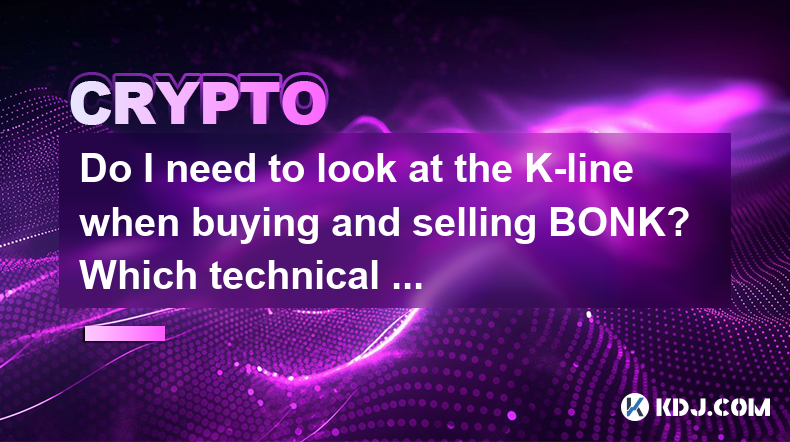
When it comes to trading cryptocurrencies like BONK, many traders often wonder whether they need to analyze the K-line and which technical indicators are most practical. The K-line, also known as a candlestick chart, is a fundamental tool in technical analysis that provides valuable insights into market trends and price movements. In this article, we will explore the importance of the K-line and discuss the most practical technical indicators for buying and selling BONK.
Understanding the K-line and Its Importance
The K-line is a graphical representation of price movements over a specific period, typically used to analyze the behavior of financial instruments like cryptocurrencies. Each K-line consists of a body and wicks, which indicate the opening, closing, high, and low prices for the chosen timeframe. By studying the K-line, traders can identify patterns and trends that help them make informed decisions.
When trading BONK, the K-line is crucial because it provides a visual representation of the market's sentiment. For instance, a long green body indicates strong buying pressure, while a long red body suggests intense selling pressure. By analyzing these patterns, traders can determine the best times to enter or exit the market.
Practical Technical Indicators for BONK Trading
To enhance their trading strategies, many traders use technical indicators in conjunction with the K-line. These indicators help to confirm trends, identify potential reversals, and generate buy or sell signals. Here are some of the most practical technical indicators for trading BONK:
Moving Averages (MA)
Moving Averages are among the most widely used indicators in technical analysis. They help smooth out price data to identify the underlying trend. There are two main types of moving averages: Simple Moving Average (SMA) and Exponential Moving Average (EMA).
- Simple Moving Average (SMA): This calculates the average price of BONK over a specific period. A common strategy is to use the 50-day and 200-day SMAs to identify long-term trends.
- Exponential Moving Average (EMA): This gives more weight to recent prices, making it more responsive to new information. The 12-day and 26-day EMAs are often used to generate trading signals.
When using moving averages, traders often look for crossovers. For example, when the shorter-term moving average crosses above the longer-term moving average, it may signal a bullish trend, indicating a good time to buy BONK.
Relative Strength Index (RSI)
The Relative Strength Index (RSI) is a momentum oscillator that measures the speed and change of price movements. It ranges from 0 to 100 and is typically used to identify overbought or oversold conditions.
- Overbought: When the RSI is above 70, it suggests that BONK may be overbought, and a price correction could be imminent.
- Oversold: When the RSI is below 30, it indicates that BONK may be oversold, and a price rebound might be on the horizon.
By monitoring the RSI, traders can determine potential entry and exit points. For instance, if the RSI indicates that BONK is oversold, it might be a good time to buy.
Bollinger Bands
Bollinger Bands consist of a middle band (usually a 20-day SMA) and two outer bands that are standard deviations away from the middle band. They help traders identify volatility and potential price breakouts.
- Narrowing Bands: When the Bollinger Bands contract, it suggests that BONK is experiencing low volatility, which may precede a significant price move.
- Widening Bands: When the bands expand, it indicates increased volatility, which could signal a potential trend continuation or reversal.
Traders often use Bollinger Bands to identify overbought or oversold conditions. For example, if BONK's price touches the upper band, it might be overbought, suggesting a potential sell signal.
MACD (Moving Average Convergence Divergence)
The MACD is a trend-following momentum indicator that shows the relationship between two moving averages of BONK's price. It consists of the MACD line, the signal line, and a histogram.
- MACD Line: This is the difference between the 12-day EMA and the 26-day EMA.
- Signal Line: This is a 9-day EMA of the MACD line.
- Histogram: This represents the difference between the MACD line and the signal line.
Traders use the MACD to identify potential buy or sell signals. For instance, when the MACD line crosses above the signal line, it may indicate a bullish trend, suggesting a good time to buy BONK. Conversely, when the MACD line crosses below the signal line, it might signal a bearish trend, indicating a potential sell opportunity.
How to Use K-line and Technical Indicators Together
Combining the K-line with technical indicators can significantly enhance a trader's ability to make informed decisions when buying and selling BONK. Here's a step-by-step guide on how to use these tools together:
- Identify the Trend: Start by analyzing the K-line to determine the overall trend of BONK. Look for patterns such as bullish or bearish engulfing, doji, or hammer patterns.
- Confirm with Moving Averages: Use moving averages to confirm the trend identified on the K-line. If the shorter-term moving average is above the longer-term moving average, it supports a bullish trend.
- Check RSI for Overbought/Oversold Conditions: Use the RSI to see if BONK is overbought or oversold. This can help you decide whether to enter or exit the market.
- Monitor Bollinger Bands for Volatility: Keep an eye on the Bollinger Bands to gauge BONK's volatility. Narrowing bands may suggest a forthcoming significant move, while widening bands indicate increased volatility.
- Use MACD for Additional Confirmation: Finally, use the MACD to confirm the signals provided by the K-line and other indicators. A bullish crossover on the MACD can reinforce a buy signal, while a bearish crossover can confirm a sell signal.
Practical Examples of Using K-line and Technical Indicators
To illustrate how to use the K-line and technical indicators in real-world trading scenarios, let's consider a few examples:
Example 1: Bullish Engulfing Pattern with Moving Averages: Suppose you observe a bullish engulfing pattern on the K-line for BONK. You then check the moving averages and see that the 50-day SMA has crossed above the 200-day SMA. This confirms a bullish trend, suggesting a good time to buy BONK.
Example 2: RSI and Bollinger Bands: Imagine the RSI for BONK is below 30, indicating an oversold condition. At the same time, the price touches the lower Bollinger Band. This combination suggests a potential price rebound, making it an opportune moment to buy BONK.
Example 3: MACD and K-line: You notice a doji pattern on the K-line, signaling potential indecision in the market. You then check the MACD and see a bullish crossover, where the MACD line crosses above the signal line. This additional confirmation suggests a good time to enter a long position on BONK.
FAQs
Q: Can I rely solely on the K-line for trading BONK?
A: While the K-line provides valuable insights into market trends and price movements, relying solely on it may not be sufficient for making well-informed trading decisions. Combining the K-line with technical indicators such as moving averages, RSI, Bollinger Bands, and MACD can provide a more comprehensive analysis and increase the accuracy of your trades.
Q: How often should I check the K-line and technical indicators for BONK?
A: The frequency with which you should check the K-line and technical indicators depends on your trading strategy and time horizon. For short-term traders, checking these tools multiple times a day may be necessary to capture quick price movements. Long-term investors might check them less frequently, perhaps daily or weekly, to monitor broader trends.
Q: Are there any other technical indicators I should consider when trading BONK?
A: Yes, there are many other technical indicators that can be useful when trading BONK. Some additional indicators to consider include the Stochastic Oscillator, Fibonacci Retracement levels, and the Average Directional Index (ADX). Each of these indicators provides unique insights into market conditions and can complement the K-line and the indicators discussed in this article.
Q: How do I know which timeframe to use for the K-line and technical indicators?
A: The choice of timeframe depends on your trading style and goals. For day traders, shorter timeframes such as 1-minute, 5-minute, or 15-minute charts may be more suitable. Swing traders might prefer 1-hour or 4-hour charts, while long-term investors could use daily or weekly charts. Experiment with different timeframes to find what works best for your trading strategy.
Disclaimer:info@kdj.com
The information provided is not trading advice. kdj.com does not assume any responsibility for any investments made based on the information provided in this article. Cryptocurrencies are highly volatile and it is highly recommended that you invest with caution after thorough research!
If you believe that the content used on this website infringes your copyright, please contact us immediately (info@kdj.com) and we will delete it promptly.
- Bitcoin, Dogecoin, Ethereum: Decoding the Crypto Buzz
- 2025-06-26 04:25:12
- Jupiter (JUP) Price: Downtrend in Danger? Trend Shift Watch!
- 2025-06-26 04:25:12
- Dogecoin Price Prediction: Crypto Analyst Eyes $1 Target – Is the Meme Coin Ready to Rally?
- 2025-06-26 04:45:12
- Coinbase, Shares, and Stablecoins: Riding the Crypto Wave
- 2025-06-26 04:30:12
- Tether, Bitcoin, and Crypto Funds: A New York Minute on the Latest Moves
- 2025-06-26 05:25:12
- Bitcoin Price: Is a Drop Incoming? Analyzing the Latest Predictions
- 2025-06-26 05:25:12
Related knowledge
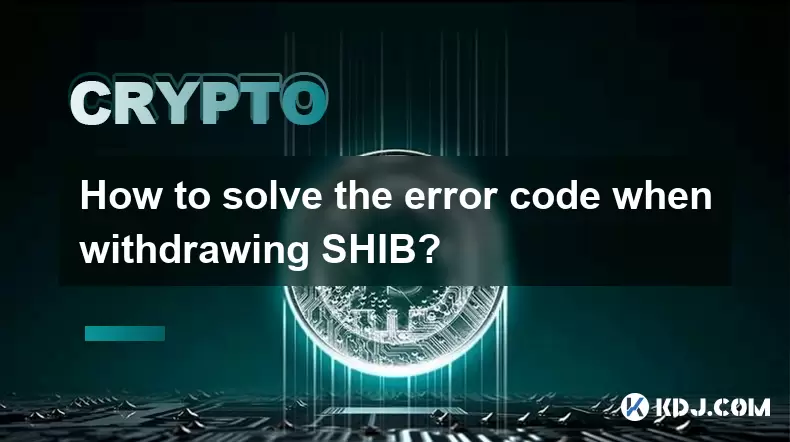
How to solve the error code when withdrawing SHIB?
May 14,2025 at 02:22am
Understanding Error Codes When Withdrawing SHIBWhen you attempt to withdraw Shiba Inu (SHIB) from an exchange or wallet, you might encounter various error codes. Understanding these error codes is crucial to successfully completing your transactions. Error codes are typically generated to inform users of specific issues that need to be addressed before ...
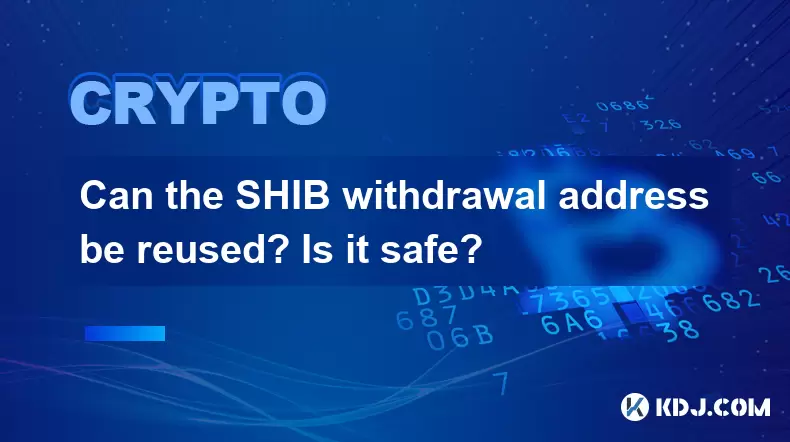
Can the SHIB withdrawal address be reused? Is it safe?
May 13,2025 at 04:42pm
Introduction to SHIB Withdrawal AddressesWhen it comes to Shiba Inu (SHIB) transactions, one of the critical aspects users need to understand is the nature and safety of withdrawal addresses. The SHIB withdrawal address plays a pivotal role in ensuring that your tokens are transferred securely from one wallet to another. A common question among users is...

What is the minimum withdrawal amount for SHIB? Is there a threshold?
May 13,2025 at 03:29pm
When it comes to withdrawing SHIB (Shiba Inu) from various cryptocurrency platforms, understanding the minimum withdrawal amount and any associated thresholds is crucial for managing your transactions efficiently. This article will delve into the specifics of SHIB withdrawals, focusing on the minimum amounts required, how these thresholds are set, and w...
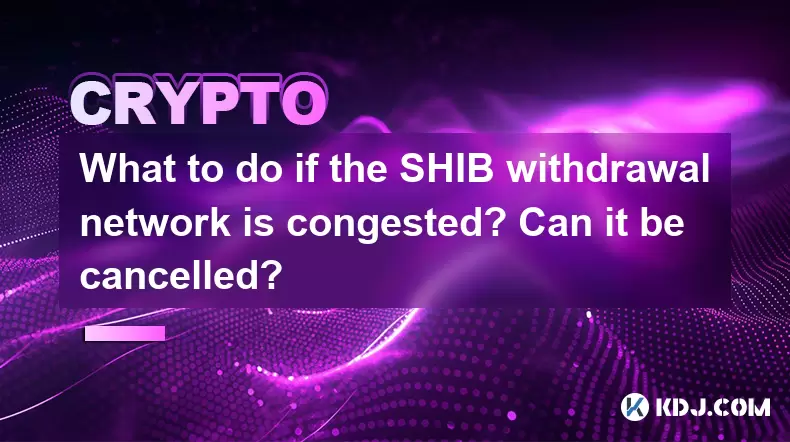
What to do if the SHIB withdrawal network is congested? Can it be cancelled?
May 13,2025 at 05:07pm
If you're facing issues with the SHIB withdrawal network being congested, it's important to understand your options and the steps you can take. Congestion in the network can lead to delays in transaction processing, and knowing whether you can cancel a pending transaction is crucial. Let's explore this topic in detail. Understanding SHIB Withdrawal Netw...
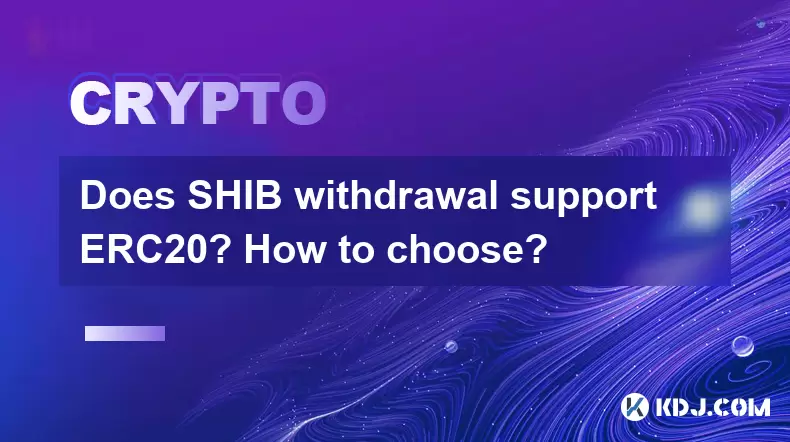
Does SHIB withdrawal support ERC20? How to choose?
May 14,2025 at 02:56am
Does SHIB withdrawal support ERC20? How to choose? Shiba Inu (SHIB) is a popular cryptocurrency that often raises questions about its withdrawal options, particularly in relation to the ERC20 token standard. This article will explore whether SHIB withdrawal supports ERC20 and provide a detailed guide on how to choose the best withdrawal method for your ...
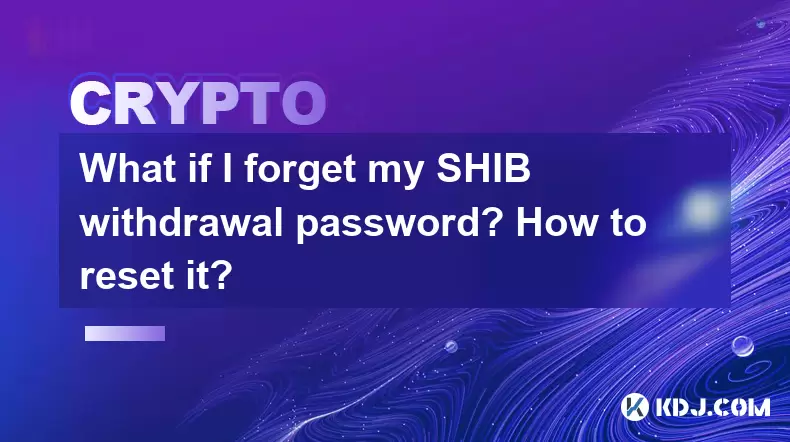
What if I forget my SHIB withdrawal password? How to reset it?
May 13,2025 at 03:15pm
Forgetting your SHIB withdrawal password can be a stressful experience, especially if you are eager to access your funds. Fortunately, there are steps you can take to reset your password and regain access to your SHIB. This article will guide you through the process of resetting your SHIB withdrawal password, ensuring that you can continue to manage you...

How to solve the error code when withdrawing SHIB?
May 14,2025 at 02:22am
Understanding Error Codes When Withdrawing SHIBWhen you attempt to withdraw Shiba Inu (SHIB) from an exchange or wallet, you might encounter various error codes. Understanding these error codes is crucial to successfully completing your transactions. Error codes are typically generated to inform users of specific issues that need to be addressed before ...

Can the SHIB withdrawal address be reused? Is it safe?
May 13,2025 at 04:42pm
Introduction to SHIB Withdrawal AddressesWhen it comes to Shiba Inu (SHIB) transactions, one of the critical aspects users need to understand is the nature and safety of withdrawal addresses. The SHIB withdrawal address plays a pivotal role in ensuring that your tokens are transferred securely from one wallet to another. A common question among users is...

What is the minimum withdrawal amount for SHIB? Is there a threshold?
May 13,2025 at 03:29pm
When it comes to withdrawing SHIB (Shiba Inu) from various cryptocurrency platforms, understanding the minimum withdrawal amount and any associated thresholds is crucial for managing your transactions efficiently. This article will delve into the specifics of SHIB withdrawals, focusing on the minimum amounts required, how these thresholds are set, and w...

What to do if the SHIB withdrawal network is congested? Can it be cancelled?
May 13,2025 at 05:07pm
If you're facing issues with the SHIB withdrawal network being congested, it's important to understand your options and the steps you can take. Congestion in the network can lead to delays in transaction processing, and knowing whether you can cancel a pending transaction is crucial. Let's explore this topic in detail. Understanding SHIB Withdrawal Netw...

Does SHIB withdrawal support ERC20? How to choose?
May 14,2025 at 02:56am
Does SHIB withdrawal support ERC20? How to choose? Shiba Inu (SHIB) is a popular cryptocurrency that often raises questions about its withdrawal options, particularly in relation to the ERC20 token standard. This article will explore whether SHIB withdrawal supports ERC20 and provide a detailed guide on how to choose the best withdrawal method for your ...

What if I forget my SHIB withdrawal password? How to reset it?
May 13,2025 at 03:15pm
Forgetting your SHIB withdrawal password can be a stressful experience, especially if you are eager to access your funds. Fortunately, there are steps you can take to reset your password and regain access to your SHIB. This article will guide you through the process of resetting your SHIB withdrawal password, ensuring that you can continue to manage you...
See all articles




















